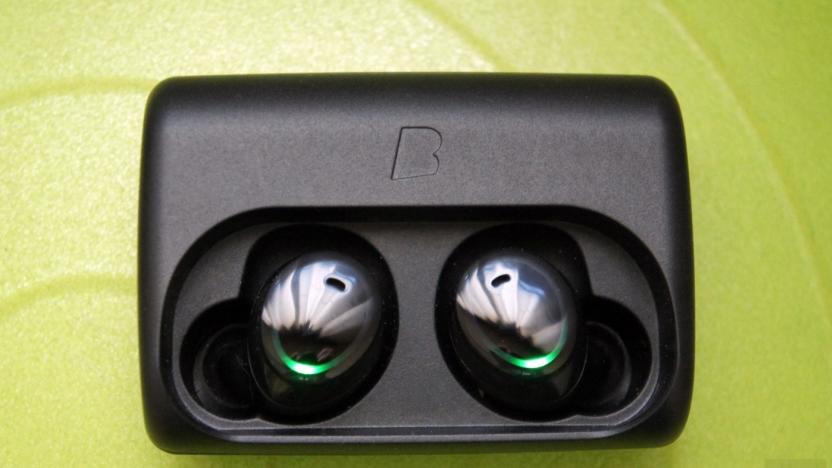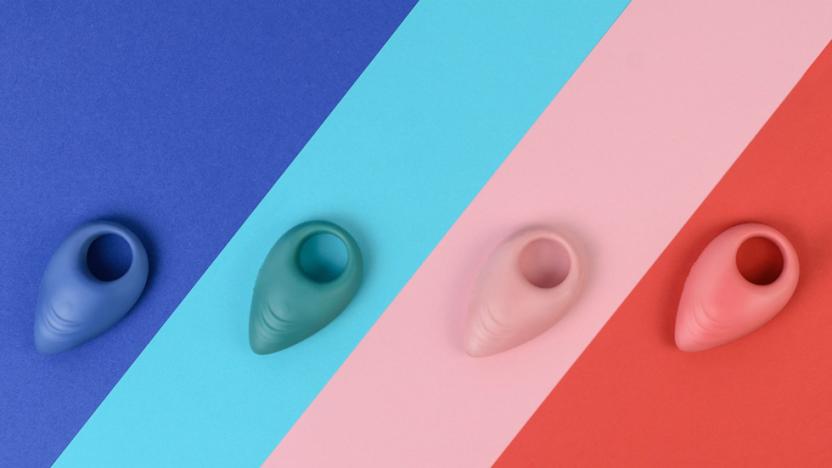activitytracker
Latest

McDonald's hands out activity trackers with Happy Meals
For more than three decades, McDonald's has handed out toys with Happy Meals. It's been long argued that the gifts incentivize parents and children to eat more fast food, leading to health issues like obesity and diabetes. While we've seen more educational and surprising tech inclusions, like VR goggles, toys that promote fitness and physical activity have been very few and far between (although the company did once include a pedometer with special Go Active! adult Happy Meals back in 2004). With the Olympics now dominating headlines, the fast-food giant is encouraging kids to get moving with a new "STEP-it" fitness tracker. Every Happy Meal sold in the US and Canada will include one of six wrist-worn pedometers that also blink slowly or quickly depending on a child's activity. "Step-it is in line with McDonald's general philosophy for Happy Meal toys, which is to make toys that encourage either physical or imagination-based play," McDonald's Canada Senior Marketing Manager, Michelle McIImoyle, explains to CityNews.

Rithmio Edge tracks weightlifting sessions with Android Wear
We've seen a number of wearable devices that track your weightlifting sessions at the gym, but Rithmio has a new app that does so with a device you may already own. The Rithmio Edge app works with Android Wear smartwatches to keep tabs on your workout, tracking both exercises and reps using the company's gesture recognition technology. The app learns your movements as you go so it can log the different exercises you fancy during those lifting routines. It also tracks reps and sets so you'll not exactly where you stand when it comes time to analyze progress.

Broods used the Microsoft Band to create music-video magic
Microsoft is no stranger to collaborating with musicians to show off creative uses for its technology. With the Music x Technology project, the company has worked with acts like Big Grams, Neon Indian, KEXP, Phantogram and others to use its Kinect to enhance the musical experience for fans. I got a first-hand look at "Realiti: Inside the Music of Grimes" back at Moogfest in May, an exhibit that let fans remix parts of a song by interacting with a mesh surface. With the help of creative agency Listen, Microsoft teamed up with electropop duo Broods to produce a music video using the Microsoft Band.

Pebble pubs its activity-tracking algorithms and Happiness app
Pebble has a few health-related updates to share following the launch of its crowdfunding campaign for three new fitness-focused smartwatches. In particular, it has revealed how its first native fitness-tracking app works by publishing the algorithms behind it, launched a mood-tracking app and published the results of a sleep study. Nathaniel Stockham, a Stanford U Ph.D. student in Neuroscience and the person who developed the app's algorithms, wrote about their details in a blog post. He explained that one of them detects and measures motion while the other counts steps and can distinguish if you're walking or running.

Garmin's new fitness tracker is a more accurate Vivosmart HR
Garmin's been busy introducing a raft of new wearables in recent weeks. First, it was the Approach X40, then the Vivomove and, most recently, the Forerunner 735XT. Each one is geared toward different types, including golfers, runners and casual users who simply want to be more active. But Garmin isn't done yet. Today, it's taking the wraps off of its Vivosmart HR+, a fitness band with a built-in GPS sensor for more accurate distance and pace tracking.

Garmin's Vivomove is a stylish fitness watch
After introducing the Approach X40 last month, Garmin's back with another new wearable. This time it's the Vivomove, a stylish fitness tracker that looks like a traditional watch. The device tracks calories, steps and monitors your sleep patterns, although it lacks feature that might be important to some, including a heart-rate sensor. Garmin did add its Move Bar to the watch face, though, which will remind you to stay active throughout the day. Vivomove also comes with an impressive one-year battery life, as well as water resistance up to 50 meters.

Jawbone widens its legal claims against Fitbit
Jawbone isn't holding back in its lawsuit campaign against Fitbit over purported corporate espionage... if anything, it's ramping things up. The company tells us that it filed a motion to widen its complaint against Fitbit after the court-ordered forensic process supposedly revealed that things were worse than originally thought. It names a new defendant, Jing Qi Weiden, who jumped ship from Jawbone to Fitbit and allegedly emailed her former employer's secret data to her Fitbit work account soon afterward. She (and her fellow defendants) effectively handed over Jawbone's product roadmap on a silver platter, if you believe the accusations.

Fossil unveils 7 more wearables, including Android Wear watches
When Fossil teased plans to have over 100 wearable devices on store shelves this year, it wasn't clowning around. On top of the abundance of devices it has unveiled so far, it's announcing seven more today. Leading the pack are two Android Wear smartwatches, the multi-finished Q Wander (above) and the slightly tougher Q Marshal. Both are available with 44mm and 46mm circular cases, wireless charging and choices of strap and body styles. They sell at the same $275 starting price as last year's Q Founder, so they might be viable choices if rivals like the Huawei Watch or Moto 360 aren't your cup of tea.

Garmin's restyled Vivoactive is a big improvement
It's fair to say that we weren't blown away by the Vivoactive smartwatch last year. But Garmin's recently announced Vivoactive HR feels a lot better. Functionally, it shares a lot with its predecessor. It has a similar low-res color touchscreen LCD and comfortable watchband, the same built-in GPS, the same week-long battery (Garmin says eight days in activity tracking mode). But it's all in a smaller, more attractive package.

Garmin's latest wearables know what sport you're playing
Garmin has revealed the Vivoactive HR sports watch and Vivofit 3 activity tracker, which look like solid improvements over the previous models in both design and features. For the Vivoactive HR smartwatch, the biggest updatel is the built-in heart rate monitor that obviates the need for a chest strap. It's also received a complete style makeover and looks significantly nicer than the chunky square design of the original Vivoactive. Using the built-in GPS, it can track running, cycling, swimming, golfing, rowing and skiing/snowboarding, with custom settings for each sport.

Your fitness tracker probably has security issues
Ever wondered how secure you are with a fitness tracker on your wrist? The researchers at Open Effect have... and their answer is "not as much as you'd probably like." In their analysis, several common trackers have flaws that theoretically let attackers follow you or intercept data. Seven out of eight used static hardware identifiers that could allow location tracking over Bluetooth, for a start. Also, the companion apps from Garmin, Jawbone, Withings and Xiaomi have holes that not only expose data, but let evildoers fake fitness info -- a problem in lawsuits where that data could be crucial evidence.

Consumer Reports backs Fitbit accuracy despite lawsuit
Given that there's a lawsuit over the accuracy of Fitbit trackers' heart rate monitors, you might be wondering how trustworthy those wearables really are. Should you buy a chest strap if you need to track your BPM? Not necessarily, if you ask Consumer Reports. It just retested both the Charge HR and Surge under more stringent conditions (additional arm locations and higher-impact workouts), and it found that both were effectively as accurate as a chest-based heart rate monitor. The only significant deviation was when using the Charge HR in particularly intense workouts, and even that could be fixed by wearing the wristband on the forearm.

Bragi Dash review: The smartest earbuds on the planet
Since I started at Engadget, it's been my life's mission (possible exaggeration) to reduce the number of gadgets I carry when I run. At one point, getting ready for a workout was something of a memory test. Where's my heart-rate strap? Did I charge my MP3 player overnight? Where's the foot-pod thingy? Are my headphones where I usually leave them? What about the GPS dongle and my running watch? You get the picture.

Razer's first smartwatch is mostly meant for fitness
Razer's first experiments with wearable tech had their share of problems (notably months of delays), but the company is willing to give it another shot... with a bit of a twist. Its just-launched Nabu Watch has the activity tracking, smartphone notifications and shake-to-share features of the original Nabu and Nabu X, but in a rugged sports watch design. Don't call it a smartwatch, though. While it technically fits that bill, Razer sees this more as a drop- and water-resistant chronograph that just happens to keep track of your app alerts and fitness. On the upside, that limited functionality leads to a seven-day battery life.

Wearable maker claims Apple and Fitbit stole its tech
There's a longstanding legal tradition in tech: a small company gets patents on a nice idea, finds only modest success selling the idea and finally sues the living daylights out of its bigger rivals. And unfortunately, that's carrying on in the wearable era. Valencell is suing both Apple and Fitbit over claims that they both infringe on four patents for accurate health monitoring, including "light-guided" devices like heart rate monitors.

Withings intros a fitness wearable with an E Ink display
Withings has spent the last eighteen months courting wealthy fitness nerds with its high-end range of Activite watches. 2016 sees the firm turn its attention towards the low-end crowd, putting the French firm in a straight-up fight with budget champions like Misfit and Xiaomi. The Withings Go is a clip-on wearable that, unlike its rivals, comes with an E-Ink display that'll keep you informed of your progress as you go about your day. The device goes on sale at some point before March, and will set you back $70.

Bragi's Dash headphones are finally here
I insert a bud into my right ear, and then the left. A few seconds later I hear a woman's voice. She explains how I can listen to music on my phone, afterwards there is silence; deafening silence. Until I connect my phone to the wireless headphones, and the lady returns, confirming that everything is good, and I'm all set. This is probably the slickest gadget set-up I have ever experienced. An experience over 5,000 backers of the Bragi Dash are about to enjoy this week. The award-winning wireless fitness-tracking headphones have been a long time coming, but if these first few moments are anything to go by, that wait has been worth it.

Under Armour and HTC built an entire fitness ecosystem
Under Armour is a king in the realm of sport apparel. But it's been laying the ground work for sometime now to become a bonafide technology company. It started some years ago with the E39 and eventually the company moved on to the Armour39, but both had fairly limited use cases. In late 2013 though, it started stockpiling fitness apps. For 2016 its bringing all the pieces together, including a partnership with HTC which is helping to design its hardware. But this isn't just another wearable, Under Armour is going all in and launching an entire ecosystem of apps and gadgets at once.

Pebble smartwatches get a built-in fitness tracking app
If you've wanted to use your Pebble smartwatch as an activity tracker so far, you've had to grab a third-party app -- unlike Apple or Google, you didn't have anything built-in. Well, that won't be an issue after today. Pebble is rolling out a firmware update to the Time, Time Steel and Time Round that introduces Pebble Health, a native fitness tracking app. It continuously tracks your step counts and sleep, like the earlier apps, but you now have coaching (built with help from Stanford University) to see where you need improvement. Your results won't exist in a vacuum, either, since they plug into Apple's HealthKit, Google Fit and (soon) third-party watch apps.

Junk technology: Why your penis pedometer is DOA
If all you want for Christmas is a penis pedometer, get ready to be disappointed. NSFW Warning: This story may contain links to and descriptions or images of explicit sexual acts.










